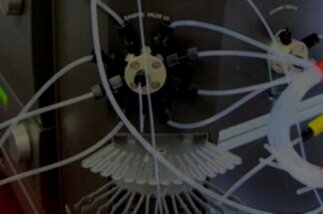
AKTA Avant Service & Repair
You rely on your equipment. Your equipment should rely on ATG.
Analytical Technologies Group specializes in the maintenance and repair of the AKTA™ family of chromatography systems, including the AKTA™ Avant. Our specialization servicing FPLCs and our focus on a narrow range of product lines enable us to provide the highest standards of service and ensure our engineers have the expert knowledge to solve just about any technical problem you may encounter. We keep most replacement parts stocked so we can provide rapid service and minimize your instrument downtime. If you really want to minimize your downtime, contact us about a service contract! Preventative maintenance from ATG will keep your AKTA™ Avant running smoothly with minimal downtime for as long as possible.
See why over 4,000 customers have trusted us to maintain over 10,000 instruments.
Tips for keeping your AKTA™ Avant in good working order:
Most standard maintenance recommendations are tracked by the maintenance manager in the system control module of the UNICORN™ software. These are filled with factory default settings. These maintenance settings are there for a reason. Keeping to the recommended maintenance schedule will help prevent problems and ensure a longer life for your AKTA™ Pure.
The pH monitor should be calibrated daily before use. Calibration should use two buffers with a difference of at least one pH unit.
Pressure monitors should be calibrated weekly.
The pump rinsing solution should be changed weekly. Always use 20% ethanol in distilled water. Each rinsing system tube should be filled with 50 ml of the rinsing solution.
Replace the inline filter at the top of the mixer every week. If the pump pressure starts to deviate more than normal from the pre-column pressure, that is also a sign the inline filter should be changed.
The fraction collector sensors should be cleaned weekly with 20% ethanol.
Once a month, check to ensure that the flow restrictor FR-902 is generating the correct back-pressure (0.2 ± 0.05 MPa).
The pump flow restrictors should be checked monthly to ensure they are preventing siphoning. If there is any siphoning, the flow restrictors should be replaced at the next service call.
The pH electrode should be replaced every six months.
Keep the instrument itself and the area around it clean. It is far easier to keep the area clean than it is to troubleshoot and repair internal components when a failure occurs.
When pH monitoring is not used, the pH electrode should be stored in a storage solution (1:1 mixture of pH 4 buffer and 1 M KNO3) inside the pH flow cell. If it is not going to be used for a week or longer, or if a week has passed since initially stored in storage solution, replace the pH electrode with the dummy electrode and store the pH electrode in storage solution.
Perform the system cleaning procedure following each use and leave the system stored in 20% ETOH to inhibit growth between uses.
Ensure all buffers are thoroughly degassed.
Avoid using old buffer solutions. It is recommended to change buffers no less than weekly. Discard any buffer which shows signs of precipitation or microbial growth.
When changing samples, buffers, or process conditions, always perform a cleaning in place protocol to flush and clean the system before performing a run. This should include cleaning of the manual injection port and pH valve, and may include the column and fraction collector, if necessary.
Having technical problems with your AKTA™ Avant?
Fast Response
We provide very prompt responses to customers within one business day.
Fast Turnaround
Our field service engineers are expediently dispatched across North America & Europe to fulfill your service request.
Expert Staff
ATG’s highly trained, highly skilled staff ensure your instruments remain in optimal condition.
Parts In Stock
To minimize instrument downtime, we stock virtually all parts for the systems in which we specialize.
AKTA™ Avant Troubleshooting Tips:
If you have a new system, you may notice that there is oil leaking from the drain hole below the pump. This is normal. Clean off any oil which has dripped and continue normal use. The oil leakage should stop within a few months of use.
Most common measurement problems, such as baseline drift, ghost peaks, or general noise, are caused by the system being dirty or having air in it. A good first step to eliminate these causes is to clean the system and purge the lines. Degas all buffers before use. Centrifuge and / or filter your samples before loading.
If you cannot communicate with your system at all, ensure the correct system is selected in UNICORN™ system control. If you have other instrument communication issues, ensure all the node IDs are set correctly.
Ensure there are no issues with the flow path. Check for leaks, twisted or kinked tubing, improperly connected tubing, and ensure the inlet tubing is correctly immersed in the buffer solution. Check to ensure the fraction collectors have been correctly prepared. If there do not appear to be issues with the flow path, inspect the inlet and inline filters for cleanliness, and check the back-pressure of the system. Change the filters to see if that fixes back-pressure issues.
Ensure your columns are cleaned and prepared according to the manufacturer’s recommendations, and ensure that they are suitable for your target proteins.
If you have issues with the UV reading, ensure your UV lamp is turned on and the cable between the UV module and ICU are connected. Ensure the module’s node ID is correct. You may also need to clean your optical fiber connectors, clean the UV flow cell, or remove dirt from the detector photo diodes. Ensure the wavelength is correct for the buffer and the flow cell is correctly installed.
Problems with your UV signal could be due to the buffers. An inverted gradient may be caused by a large difference in the refractive index between the buffers. Distorted protein peaks in IEX gradients could be cased by rapid changes in the refractive index of the buffer and may be fixed by running with reversed flow through the UV cell (note that you will need to replace the tubing between the UV and conductivity cells and update the total delay volume if you do so).
Unstable conductivity measurements could be due to a dirty conductivity flow cell, indicate that the conductivity meter needs to be replaced, or be due to a change in the ambient temperature.
An unstable pH signal may indicate that the electrode needs to be regenerated. Place it electrode in deionized water for 30 minutes followed by 30 minutes in a buffer with pH 4.
Temperature related errors, such as from the UV monitors, pH monitor, pressure monitors, pump, valves, mixer, fraction collector, air sensor, etc., could be caused by insufficient air flow to the instrument. Ensure the air intakes are unobstructed and have at least an inch of clearance. Ensure the room temperature is below 35°C. Turn the instrument off and wait for it to cool. If the problem is recurring, contact us for service.
Pressure or flow issues may be caused by obstructions in the flow path, leaking connections, or problems with the pump. Problems with pump pressure that do not have other noticeable causes (leaks, blockages, etc.) may indicate the pump springs, pistons, or piston seals require replacement, however low flow issues could also be due to dust or salt crystals in the pump head check valves. Leakage near the pump head is a definite sign that a piston seal or rinsing membrane require replacement or were improperly installed.
If the dispenser head is failing to detect drops, check for and purge any air in the flow path, clean the DropSync sensor diode windows, and / or try decreasing the flow rate.
Issues with the cassette tray are usually physical in nature: objects or dirt under the cassette tray, wrong tube or plate dimensions, incorrect positioning of the cassette tray, or tubes / plates being incorrectly placed. Also ensure that the cassette tray positioning discs are in their proper position in the Frac chamber.
If the fraction collector is not dispensing into the correct well or tube, ensure the cassette and plate are correctly positioned, ensure wells are not more than 25% full, and clean the nozzle and DropSync sensor diode windows.
If performing a run in a cold room where you previously have not, you may receive a high pressure alarm. Run at a lower flow rate to avoid a high pressure alarm.
If you experience too slow of a pressure build or a pressure overshoot when using pressure control or constant pressure flow, your I factor setting is likely too low or too high, respectively.

